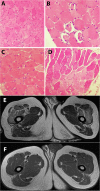Severe acute myopathy following SARS-CoV-2 infection: a case report and review of recent literature
- PMID: 33883014
- PMCID: PMC8058144
- DOI: 10.1186/s13395-021-00266-5
Severe acute myopathy following SARS-CoV-2 infection: a case report and review of recent literature
Abstract
Background: SARS-CoV2 virus could be potentially myopathic. Serum creatinine phosphokinase (CPK) is frequently found elevated in severe SARS-CoV2 infection, which indicates skeletal muscle damage precipitating limb weakness or even ventilatory failure.
Case presentation: We addressed such a patient in his forties presented with features of severe SARS-CoV2 pneumonia and high serum CPK. He developed severe sepsis and acute respiratory distress syndrome (ARDS) and received intravenous high dose corticosteroid and tocilizumab to counter SARS-CoV2 associated cytokine surge. After 10 days of mechanical ventilation (MV), weaning was unsuccessful albeit apparently clear lung fields, having additionally severe and symmetric limb muscle weakness. Ancillary investigations in addition with serum CPK, including electromyogram, muscle biopsy, and muscle magnetic resonance imaging (MRI) suggested acute myopathy possibly due to skeletal myositis.
Conclusion: We wish to stress that myopathogenic medication in SARS-CoV2 pneumonia should be used with caution. Additionally, serum CPK could be a potential marker to predict respiratory failure in SARS-CoV2 pneumonia as skeletal myopathy affecting chest muscles may contribute ventilatory failure on top of oxygenation failure due to SARS-CoV2 pneumonia.
Keywords: Electromyogram; Guillain-Barré syndrome; Myopathy; Nerve conduction; SARS-CoV2.
Conflict of interest statement
No authors have financial, professional, or personal conflict of interest that may influence this manuscript to disclose.
Figures


Similar articles
-
Severe Covid-19.N Engl J Med. 2020 Dec 17;383(25):2451-2460. doi: 10.1056/NEJMcp2009575. Epub 2020 May 15. N Engl J Med. 2020. PMID: 32412710 Review. No abstract available.
-
A Patient with Fever and Dyspnea.N Engl J Med. 2020 Nov 5;383(19):e111. doi: 10.1056/NEJMimc2019378. N Engl J Med. 2020. PMID: 33211933 No abstract available.
-
Severe COVID-19 Infections-Knowledge Gained and Remaining Questions.JAMA Intern Med. 2021 Jan 1;181(1):9-11. doi: 10.1001/jamainternmed.2020.6047. JAMA Intern Med. 2021. PMID: 32945833 No abstract available.
-
Neuromuscular involvement in COVID-19 critically ill patients.Clin Neurophysiol. 2020 Dec;131(12):2809-2816. doi: 10.1016/j.clinph.2020.09.017. Epub 2020 Oct 15. Clin Neurophysiol. 2020. PMID: 33137571 Free PMC article.
-
Treatment of COVID-19: a review of current and prospective pharmacotherapies.Br J Hosp Med (Lond). 2021 Mar 2;82(3):1-9. doi: 10.12968/hmed.2021.0112. Epub 2021 Mar 12. Br J Hosp Med (Lond). 2021. PMID: 33792391 Review.
Cited by
-
Predictor factors for non-invasive mechanical ventilation failure in severe COVID-19 patients in the intensive care unit: a single-center retrospective study.J Anesth Analg Crit Care. 2022 Feb 15;2(1):10. doi: 10.1186/s44158-022-00038-7. J Anesth Analg Crit Care. 2022. PMID: 37386578 Free PMC article.
-
Prevalence of Myositis-Specific Autoantibodies and Myositis-Associated Autoantibodies in COVID-19 Patients: A Pilot Study and Literature Review.Cureus. 2022 Sep 29;14(9):e29752. doi: 10.7759/cureus.29752. eCollection 2022 Sep. Cureus. 2022. PMID: 36324355 Free PMC article.
-
Musculoskeletal complications in long COVID-19: A systematic review.World J Virol. 2022 Nov 25;11(6):485-495. doi: 10.5501/wjv.v11.i6.485. World J Virol. 2022. PMID: 36483107 Free PMC article.
-
The Musculoskeletal Involvement After Mild to Moderate COVID-19 Infection.Front Physiol. 2022 Mar 18;13:813924. doi: 10.3389/fphys.2022.813924. eCollection 2022. Front Physiol. 2022. PMID: 35492595 Free PMC article. Review.
-
Juvenile idiopathic inflammatory myositis: an update on pathophysiology and clinical care.Nat Rev Rheumatol. 2023 Jun;19(6):343-362. doi: 10.1038/s41584-023-00967-9. Epub 2023 May 15. Nat Rev Rheumatol. 2023. PMID: 37188756 Free PMC article. Review.
References
-
- Tsai LK, Hsieh ST, Chao CCm, Chen YC, Lin YH, Chang SC, Chang YC Neuromuscular disorders in severe acute respiratory syndrome. Archives of neurology 2004; 61(11): 1669-1673, DOI: 10.1001/archneur.61.11.1669. - PubMed
Publication types
MeSH terms
Substances
LinkOut - more resources
Full Text Sources
Other Literature Sources
Medical
Miscellaneous

